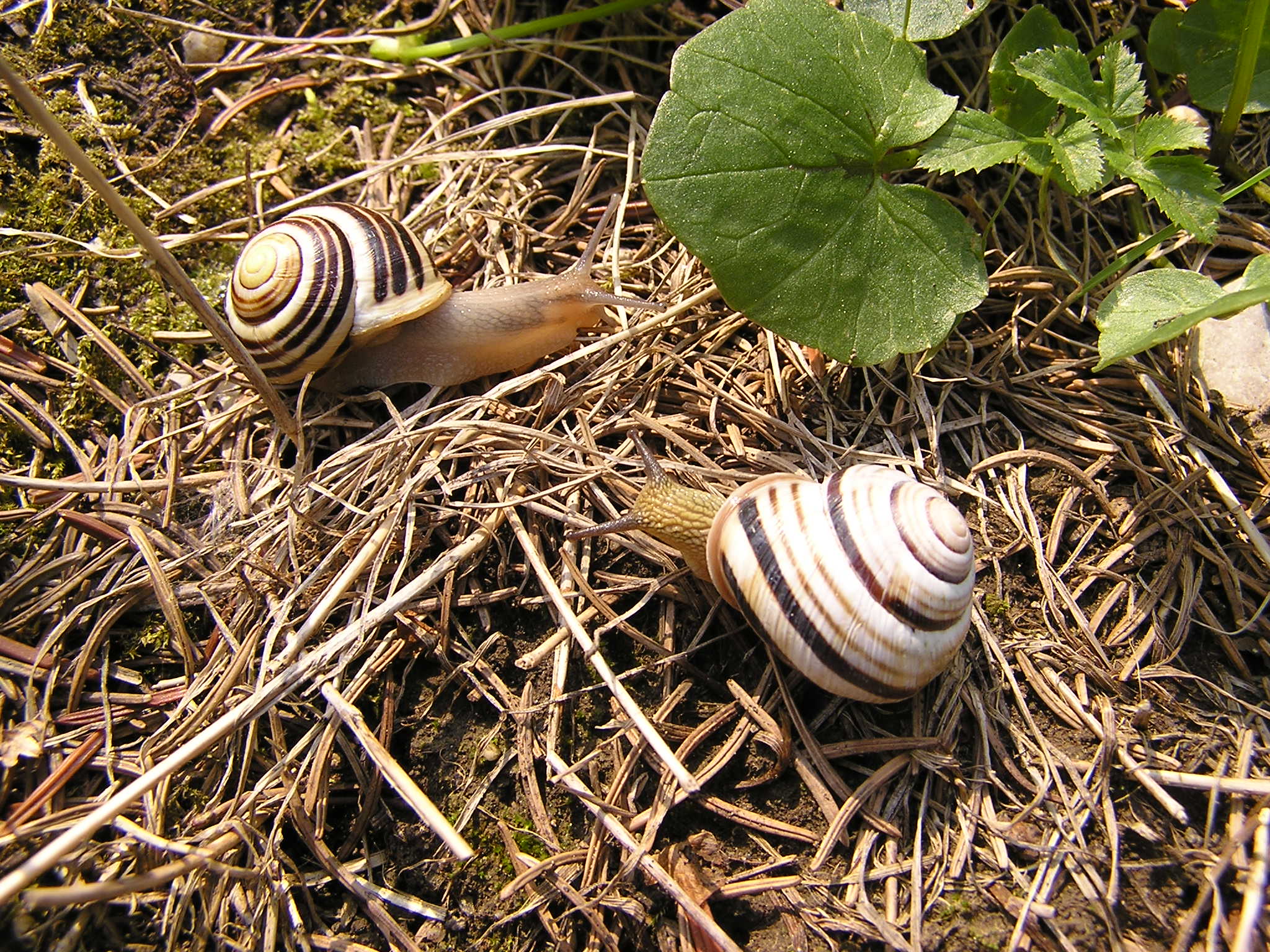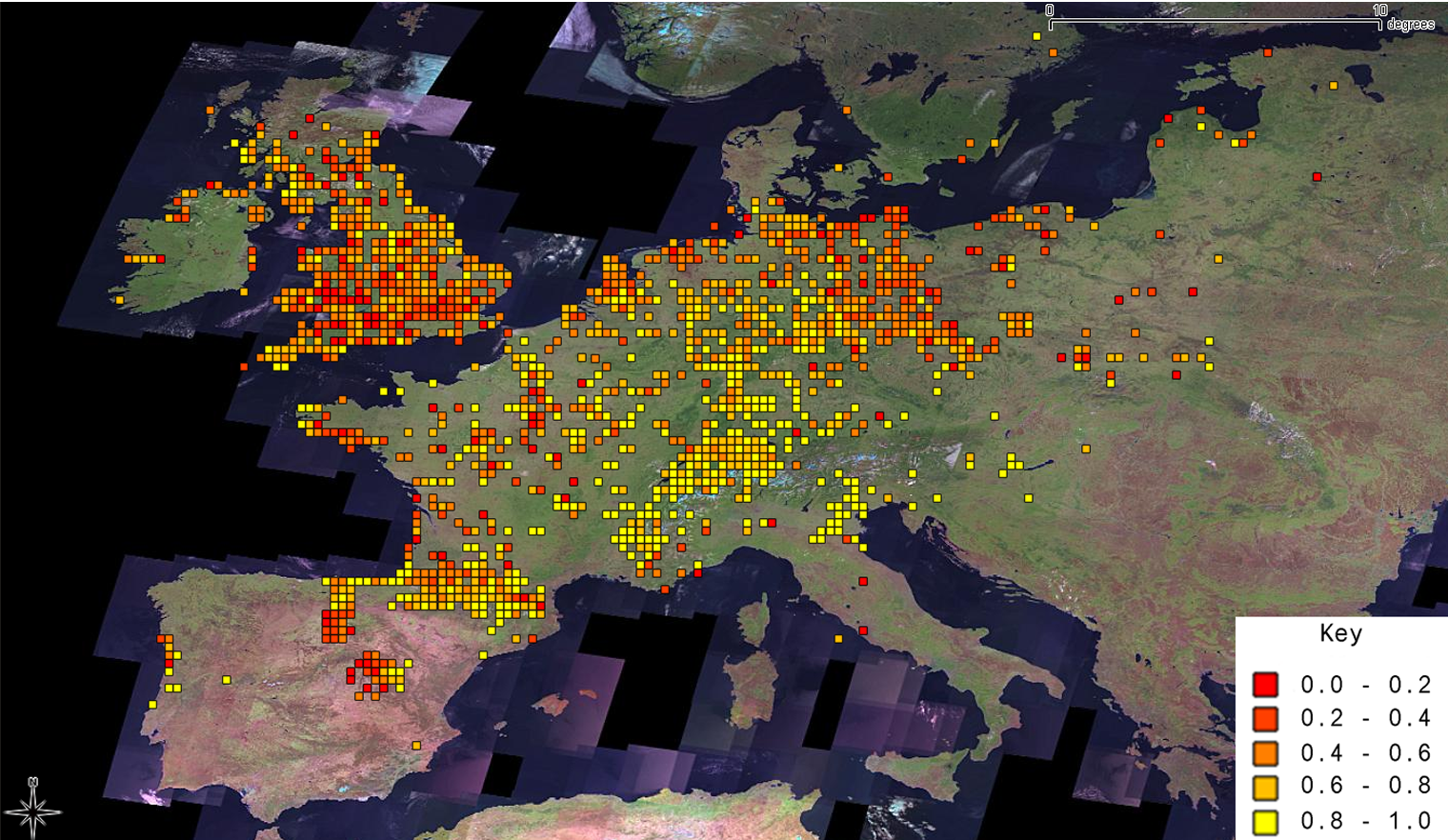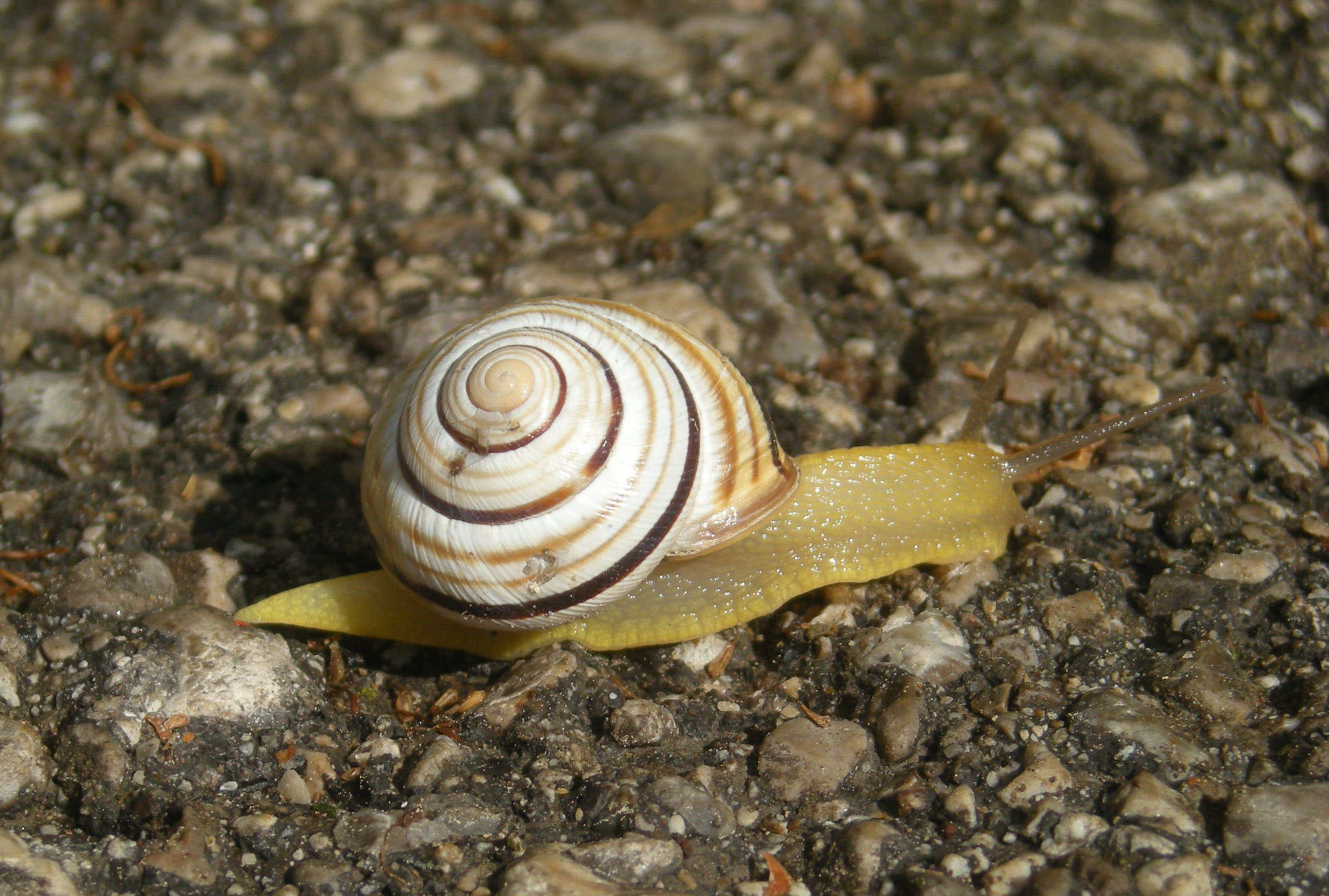|
Cepaea
''Cepaea'' is a genus of large air-breathing land snails, terrestrial molluscs, terrestrial pulmonate gastropod molluscs in the family Helicidae. The shells are often brightly coloured and patterned with brown stripes. The two living species in this genus, ''C. nemoralis'' and ''C. hortensis'', are widespread and common in Western and Central Europe. In North America, ''C. hortensis'' is Native species, native on the northeast coast, but both species have been introduced elsewhere, and they are also spreading further east in Europe. Both have been influential model organisms, model species for ongoing studies of genetics and natural selection. Like many Helicidae, these snails use love darts during mating. Species For a long time, four living species were classified in the genus ''Cepaea''. However, Molecular phylogenetics, molecular phylogenetic studies suggested that two of them should be placed in the genera ''Macularia'' and ''Caucasotachea'', which are not immediate relativ ... [...More Info...] [...Related Items...] OR: [Wikipedia] [Google] [Baidu] |
Cepaea Nemoralis
The grove snail, brown-lipped snail or lemon snail (''Cepaea nemoralis'') is a species of air-breathing land snail, a terrestrial molluscs, terrestrial pulmonate gastropod mollusc. It is one of the most common large species of land snail in Europe, and has been introduced to North America. ;Subspecies: * ''Cepaea nemoralis etrusca'' (Rossmässler, 1835) * ''Cepaea nemoralis nemoralis'' (Linnaeus, 1758) ''Cepaea nemoralis'' is the type species of the genus ''Cepaea''. It is used as a model organism in ecological genetics, including in citizen science projects. Description ''Cepaea nemoralis'' is among the largest and, because of its bright colouration, one of the best-known snails in Western Europe. The colour of the gastropod shell, shell is highly variable; it ranges from brown, through pink, to yellow or even whitish, with or without one to five dark-brown bands. Names for many colour variants were coined in the nineteenth century but this system has been replaced by an inde ... [...More Info...] [...Related Items...] OR: [Wikipedia] [Google] [Baidu] |
Cepaea Hortensis And Cepaea Vindobonensis
''Cepaea'' is a genus of large air-breathing land snails, terrestrial pulmonate gastropod molluscs in the family Helicidae. The shells are often brightly coloured and patterned with brown stripes. The two living species in this genus, ''C. nemoralis'' and ''C. hortensis'', are widespread and common in Western and Central Europe. In North America, ''C. hortensis'' is native on the northeast coast, but both species have been introduced elsewhere, and they are also spreading further east in Europe. Both have been influential model species for ongoing studies of genetics and natural selection. Like many Helicidae, these snails use love darts during mating. Species For a long time, four living species were classified in the genus ''Cepaea''. However, molecular phylogenetic studies suggested that two of them should be placed in the genera '' Macularia'' and '' Caucasotachea'', which are not immediate relatives of either ''Cepaea'' or each other: * ''Cepaea hortensis'' (O. F. Müller ... [...More Info...] [...Related Items...] OR: [Wikipedia] [Google] [Baidu] |
White-lipped Snail
The white-lipped snail or garden banded snail, scientific name ''Cepaea hortensis'', is a large species of air-breathing land snail, a terrestrial pulmonate gastropod mollusc in the family Helicidae. The only other species in the genus is ''Cepaea nemoralis''. Shell description ''Cepaea hortensis'' has a shell up to in diameter, tending to be slightly smaller than ''C. nemoralis''. The umbilicus is closed in adults, but narrowly open in juveniles. Although the shells of ''C. hortensis'' are most commonly yellow, they exhibit a range of background colours from brown through pink to pale yellow, and up to five brown bands may be present, some of which may fuse with their neighbours. This polymorphism, which is shared with ''Cepaea nemoralis'', has been the subject of considerable research. Identification In most areas adults of ''C. hortensis'' can be distinguished by the pale colouration of the lip around the shell aperture, whereas it is typically brown in ''C. nemoral ... [...More Info...] [...Related Items...] OR: [Wikipedia] [Google] [Baidu] |
Caucasotachea Vindobonensis
''Caucasotachea vindobonensis'' is a large species of air-breathing land snail, a terrestrial molluscs, terrestrial pulmonate gastropod in the family Helicidae. The scientific name is derived from the Celtic settlement Vindobona, now known as Vienna, the capital of Austria. This species was formerly assigned to the genus ''Cepaea''. However, DNA sequences revealed that this species is not closely related to ''Cepaea'', but belongs instead to the genus ''Caucasotachea''. Description The right-hand coiled, globular shell of ''C. vindobonensis'' is 17–21 mm high and 20–25 mm broad with 5.5–6 whorls. In adults, the Gastropod_shell#Parts_of_the_shell, umbilicus is completely covered. The Gastropod_shell#Parts_of_the_shell, lip is brown at its inner end becoming pale towards the Gastropod_shell#Parts_of_the_shell, suture; this distinguishes it from the conchological similar ''Cepaea hortensis'' (usually pure white lip) and ''Cepaea nemoralis'' (usually a dark brown li ... [...More Info...] [...Related Items...] OR: [Wikipedia] [Google] [Baidu] |
Helicidae
Helicidae is a large, diverse family of western Palaearctic, medium to large-sized, air-breathing land snails, sometimes called the "typical snails." It includes some of the largest European land snails, several species are common in anthropogenic habitats, and some became invasive on other continents. A number of species in this family are valued as food items, including '' Cornu aspersum'' (formerly ''Helix aspersa;'' "petit gris") the brown or garden snail, and '' Helix pomatia'' (the " escargot"). The biologies of these two species in particular have been thoroughly studied and documented. Shell description The shells are usually flattened or depressed conical. Globular shells are found in the genera '' Helix'', '' Maltzanella'', '' Lindholmia'', '' Cornu'', '' Cantareus'', '' Eremina'', and '' Idiomella''. One species, '' Cylindrus obtusus'', has a cylindrical shell. In some genera, especially in '' Cepaea'', the shells are brightly colored and patterned. Anatomy Hel ... [...More Info...] [...Related Items...] OR: [Wikipedia] [Google] [Baidu] |
Love Dart
A love dart (also known as a gypsobelum, shooting darts, or just as darts) is a sharp, calcium carbonate, calcareous or chitinous Dart (missile), dart which some hermaphroditic land snails and slugs create. Love darts are both formed and stored internally in a dart sac. These darts are made in sexually mature animals only, and are used as part of the sequence of events during courtship display, courtship, before actual mating takes place. Darts are quite large compared to the size of the animal: in the case of the semi-slug genus ''Parmarion'', the length of a dart can be up to one fifth that of the semi-slug's foot. The process of using love darts in snails is a form of sexual selection. Prior to copulation (zoology), copulation, each of the two snails (or slugs) attempts to "shoot" one (or more) darts into the other snail (or slug). There is no organ to receive the dart; this action is more analogous to stabbing, or to being shot with an arrow or flechette. The dart does not ... [...More Info...] [...Related Items...] OR: [Wikipedia] [Google] [Baidu] |
Macularia Sylvatica
'' Macularia sylvatica'' is a medium-sized species of air-breathing dextral land snail, a terrestrial pulmonate gastropod mollusc in the family Helicidae. It was once seen as a close relative of the grove snail (''Cepaea nemoralis''), but does in fact not belong to the genus ''Cepaea ''Cepaea'' is a genus of large air-breathing land snails, terrestrial molluscs, terrestrial pulmonate gastropod molluscs in the family Helicidae. The shells are often brightly coloured and patterned with brown stripes. The two living species in ...'' at all. Geographic distribution and habitat This west-Alpine species occurs in Germany, Italy, France, Liechtenstein and Switzerland.Francisco W. Welter-Schultes: ''European non-marine molluscs, a guide for species identification = Bestimmungsbuch für europäische Land- und Süsswassermollusken.'' A1-A3 S., 679 S., Q1-Q78 S., Göttingen, Planet Poster Ed., 2012 , (S. 368) The vertical distribution extends from 265 m to 2560 m a.s.l.Turner H, Kuipe ... [...More Info...] [...Related Items...] OR: [Wikipedia] [Google] [Baidu] |
Caucasotachea
''Caucasotachea'' is a genus of medium-sized air-breathing land snails, terrestrial pulmonate gastropod molluscs in the family Helicidae. Species The following extant species are currently classified in the genus: * ''Caucasotachea atrolabiata'' (Krynicki, 1833) * ''Caucasotachea leucoranea'' ( Mousson, 1863) * ''Caucasotachea vindobonensis'' ( C. Pfeiffer, 1828) Several fossil taxa are placed to ''Caucasotachea'': * † ''Caucasotachea andrussovi'' Steklov, 1966 * † ''Caucasotachea beringi'' Schütt, 1985 * † ''Caucasotachea candirensis'' Schütt, 1985 * † ''Caucasotachea kubanica'' Steklov, 1966 * † ''Caucasotachea phrygomysica ''Caucasotachea'' is a genus of medium-sized air-breathing land snails, terrestrial pulmonate gastropod molluscs in the family Helicidae. Species The following extant species are currently classified in the genus: * ''Caucasotachea atrolabiat ...'' (Oppenheim, 1919) Genetics The haploid number of chromosomes is 25 (''C. vindobonensis ... [...More Info...] [...Related Items...] OR: [Wikipedia] [Google] [Baidu] |
Sedum Cepaea
''Sedum cepaea'', the pink stonecrop, is a species of flowering plant in the family Crassulaceae. It has a Mediterranean distribution, but generally in the mountains, and extending into France as far north as Paris, and it has been introduced to Belgium, Germany, and, it seems, New Zealand. A bushy, succulent annual, it can reach . References cepaea ''Cepaea'' is a genus of large air-breathing land snails, terrestrial molluscs, terrestrial pulmonate gastropod molluscs in the family Helicidae. The shells are often brightly coloured and patterned with brown stripes. The two living species in ... Flora of Switzerland Flora of Southwestern Europe Flora of Southeastern Europe Flora of the East Aegean Islands Flora of Turkey Flora of Syria Flora of North Africa Taxa named by Carl Linnaeus Plants described in 1753 {{Crassulaceae-stub ... [...More Info...] [...Related Items...] OR: [Wikipedia] [Google] [Baidu] |
Land Snail
A land snail is any of the numerous species of snail that live on land, as opposed to the sea snails and freshwater snails. ''Land snail'' is the common name for terrestrial molluscs, terrestrial gastropod mollusks that have gastropod shell, shells (those without shells are known as slugs). However, it is not always easy to say which species are terrestrial, because some are more or less amphibious between land and fresh water, and others are relatively amphibious between land and salt water. Land snails are a Polyphyly, polyphyletic group comprising at least ten independent evolutionary transitions to terrestrial life (the last common ancestor of all gastropods was marine). The majority of land snails are pulmonates that have a lung and breathe air. Most of the non-pulmonate land snails belong to lineages in the Caenogastropoda, and tend to have a gill and an operculum (gastropod), operculum. The largest clade of non-pulmonate land snails is the Cyclophoroidea, with more than 7,0 ... [...More Info...] [...Related Items...] OR: [Wikipedia] [Google] [Baidu] |
Gastropod
Gastropods (), commonly known as slugs and snails, belong to a large Taxonomy (biology), taxonomic class of invertebrates within the phylum Mollusca called Gastropoda (). This class comprises snails and slugs from saltwater, freshwater, and from the land. There are many thousands of species of sea snails and sea slug, slugs, as well as freshwater snails, freshwater limpets, land snails and slugs. The class Gastropoda is a diverse and highly successful class of mollusks within the phylum Mollusca. It contains a vast total of named species, second only to the insects in overall number. The fossil history of this class goes back to the Furongian, Late Cambrian. , 721 family (taxonomy), families of gastropods are known, of which 245 are extinct and appear only in the fossil record, while 476 are currently neontology, extant living fossil, with or without a fossil record. Gastropoda (previously known as univalves and sometimes spelled "Gasteropoda") are a major part of the phylum Mo ... [...More Info...] [...Related Items...] OR: [Wikipedia] [Google] [Baidu] |
Mollusc
Mollusca is a phylum of protostome, protostomic invertebrate animals, whose members are known as molluscs or mollusks (). Around 76,000 extant taxon, extant species of molluscs are recognized, making it the second-largest animal phylum after Arthropoda. The number of additional fossil species is estimated between 60,000 and 100,000, and the proportion of undescribed species is very high. Many taxa remain poorly studied. Molluscs are the largest marine biology, marine phylum, comprising about 23% of all the named marine organisms. They are highly diverse, not just in size and anatomical structure, but also in behaviour and habitat, as numerous groups are freshwater mollusc, freshwater and even terrestrial molluscs, terrestrial species. The phylum is typically divided into 7 or 8 taxonomy (biology), taxonomic class (biology), classes, of which two are entirely extinct. Cephalopod molluscs, such as squid, cuttlefish, and octopuses, are among the most neurobiology, neurologi ... [...More Info...] [...Related Items...] OR: [Wikipedia] [Google] [Baidu] |









